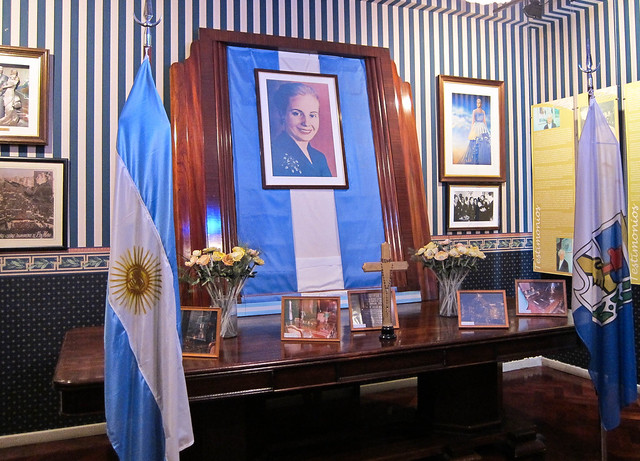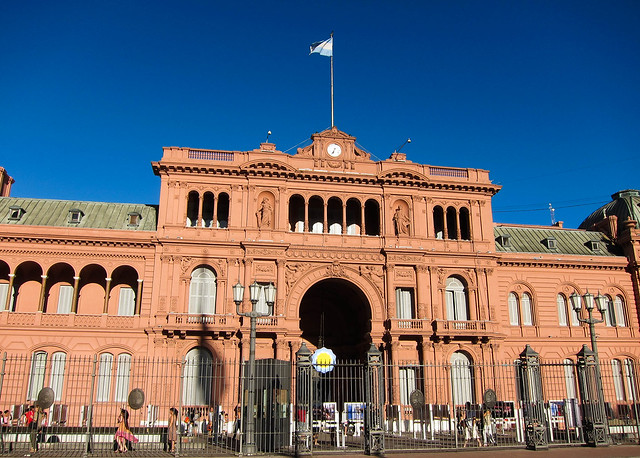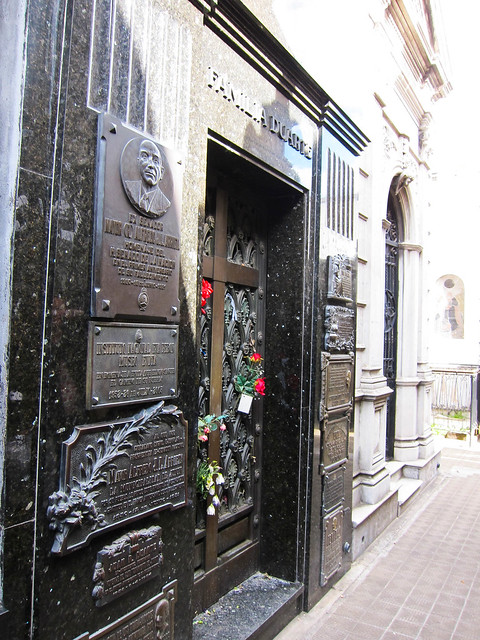Before I met Mike and tackled this whole “learn spanish and move to Buenos Aires” project, my only frame of reference for Argentina was the movie Evita. I loved that movie when I was 12; I listened to the soundtrack over and over. When I arrived here in Buenos Aires I was thrilled to see that yes, Evita love is a real thing here.
It’s a bigger deal than I could have guessed really. Her picture is plastered around the city, her name is glorified and major political parties still invoke her name. Before we visited Mike’s grandmother in the suburbs he warned me, “Don’t bring up Evita to my grandmother. She’ll cry.”

So who was Evita, and why do the Argentineans love her so much? How does someone go from a poor peasant to a political leader to an immortal legend? I went on a dedicated Evita tour with Viator to find out.
It was very nearly a private tour, just myself and an older woman from Brazil. Our guide, young and beautiful like all Argentine women, switched easily back and forth between English and Spanish as we drove across the city. Over the course of several hours we visited several of the locations best associated with the woman behind the legend.
Like all good legends Eva Peron came out of nowhere. She was born in 1919 as an illegitimate child in a very poor family. She moved to Buenos Aires and steadily worked her way up the fame ladder, first as a broadcaster and then as an actress. She wasn’t particularly good but she became quite famous anyways. At a fundraiser one night she met the vice president of Argentina, Juan Peron. He was twice her age but the two hit it off (my guide tells me she went home with him that night), and moved in with him immediately, which you can imagine was quite scandalous for 1944.
Eva campaigned hard for Peron to be president. She gave rousing populist speeches that galvanized the working class. After she became first lady she became the charitable hand of his administration: organizing public works, women’s shelters and other services for the poor. In the past the political leaders of Argentina had ignored the struggles of the lower classes, but Evita glorified them.

Our tour took us to the Department of Agriculture building where Eva kept her offices, now preserved as a monument to her. She wasn’t content just to be a charitable first lady, and she was heavily involved in politics. She campaigned hard for women’s rights and became president of the Female Peronist Party. As an ambassador for the country she traveled through Europe. When Peron ran for re-election in 1951 many wanted her to run for Vice President.
In August, 1951 2 million people gathered outside the Casa Rosada to demand that she run for vice president. It is believed to be the largest gathering of people in support of a female politician in history.

Eva had to turn down the honor, for both political and health reasons. Around this time she was diagnosed with advanced cervical cancer. Her health deteriorated quickly, reducing her to a mere 79 pounds. In 1952 she was the first woman in Argentina to vote, casting a ballot for her husband from her hospital bed. She died shortly after his re-election. She was only 33 years old.
Of course the nation fell into deep mourning. Eva’s corpse was embalmed in the style of Lenin or Mao, and thousands and thousands of people lined up to catch a glimpse and say goodbye. There were plans to build a mausoleum so grand that it would be larger than the statue of liberty. Once Peron was overthrown however, the corpse disappeared and went on some really bizarre and crazy adventures before finally coming to rest at Recoleta Cemetery. Despite being a very modest tomb, it’s still the most popular site in the entire cemetery.

After learning her life story, it’s no mystery to me why Evita is so famous and adored. She died young and beautiful, and she embodied important parts of Argentine culture. She was basically a mix of Angelina Jolie, Hillary Clinton and Princess Di all combined with a strong pinch of Argentine nationalism thrown in.
Even now she’s still influencing politics. “Cristina (current president Cristina Kerchner) tries to be like Evita,” my guide tells me huffily, “but she can’t, she doesn’t come from the people like Eva did.”
Our last stop on the tour was the Evita Museum in Palermo. Here you can really see the cult of Evita on full display. Her fabulous designer dresses are on display alongside artifacts from her childhood, clips of her films, even her death mask.


After the tour I felt like I had a much better grasp of the true (non-Madonna related) story of Eva Peron. It would be easy for visitors to the country to just see her as a kitschy mascot, but she was a real, fascinating woman, and by understanding what she was all about, I feel like I understand Argentina a little better.
Thank you to Viator for the complimentary Evita tour in Buenos Aires.
